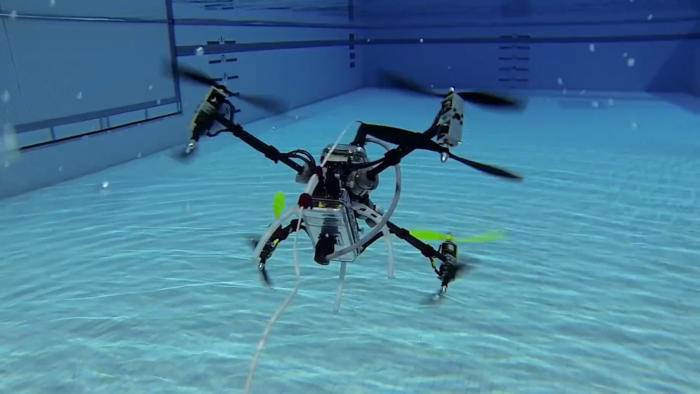The prototype is being developed by Rutgers University in New Jersey

A prototype of Rutgers University’s amphibious drone being tested in a pool.
Credit:
Rutgers University
We’ve all heard of amphibious cars, but what about amphibious drones? Researchers at Rutgers University took on the challenge of building an unmanned vehicle that can soar through the air and seamlessly transition to swim through the water. They call it the Naviator.
Amphibious aircraft aren’t a new concept. In fact, inventors have been playing with the idea since the 1930s, when Boris Ushakov, a student engineer at a Soviet military academy, proposed a three-engine floatplane that could flood its fuselage to sink beneath the water and torpedo its enemies when they got close. The project was scrapped before it was ever built.
Other attempts followed, including a flying submarine concept masterminded by Donald Reid in 1962. Like Ushakov’s aircraft, Reid’s vehicle was a floatplane built using parts from other planes. Reid’s flying submarine proved capable of diving approximately 3.5 meters but was unable to sustain long flights because of its enormous weight. Which leads us to the Naviator.
The real challenge was building a craft that can function equally well in water and in the air and was able to transition repeatedly between the two, said Michael Benyo, who’s in the engineering department at Rutgers University.
“What we did was we decided we had two sets of propellers, the propellers above and the propellers below,” he said. “There is a sensor that detects when the drone is in the water. It shuts off the upper propeller, and the lower propeller pulls it into the water seamlessly and smoothly.”
 Rutgers University
Rutgers University The Naviator amphibious drone uses two sets of propellers to help it transition from air to water.
Once the drone is underwater, both sets of propellers kick back in but at a much slower speed. This allows the Naviator to run for as long as 24 hours in the water, compared to one hour of flight time. The drone is operated using radio waves and a regular drone controller, though this method of navigation becomes problematic as soon as it hits the water.
“You really can’t communicate [with the drone] under water,” Benyo said. “Radio signals just die, within a few meters. So you really can’t use normal radio communications. The normal controls just won’t work.”
There are limited ways to communicate under water using ultrasound, “and we’re in the process of refining that,” he added. “But basically, you got to program it, set it free, and have it come back to you.”
 Rutgers University
Rutgers University Researchers must currently use a cable to communicate with the drone while it’s submerged, as radio waves break down in water.
So far, most of the funding for the Naviator has come from the U.S. Navy, which hopes to use the technology for search-and-rescue operations, locating underwater mines, and conducting at-sea fleet inspections.
But the Naviator team also sees commercial applications, such as bridge inspections, data collection, and mapping. The team is currently working on a new design that will have a seven-foot wingspan and be able to carry payloads more than three pounds. Benyo predicts the Naviator will hit the commercial market less than a year.







